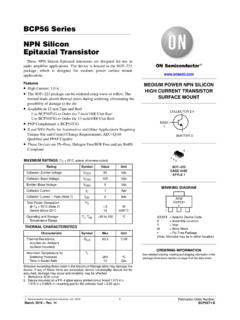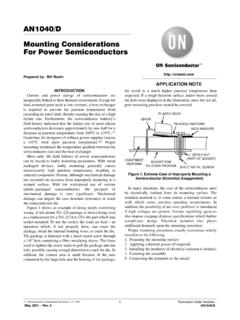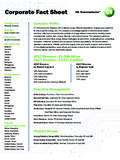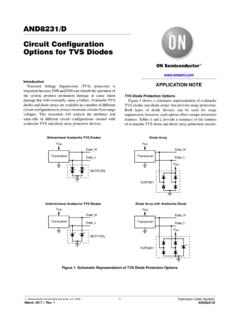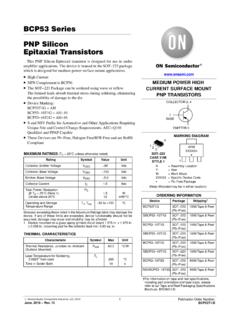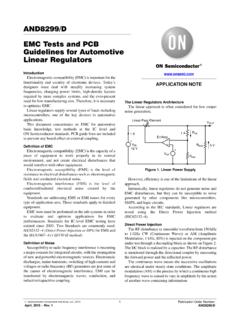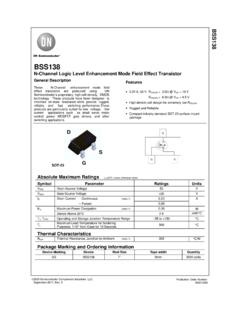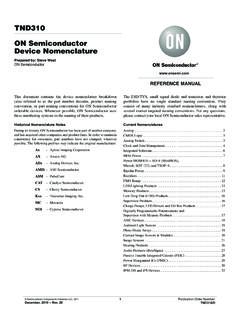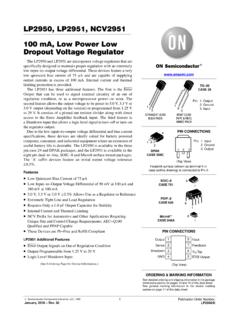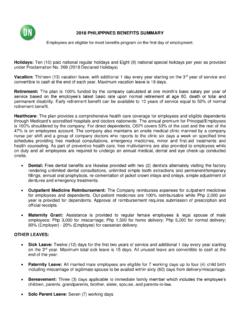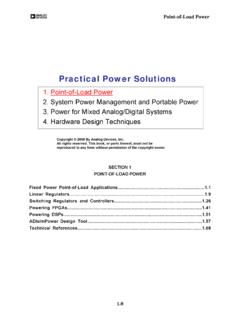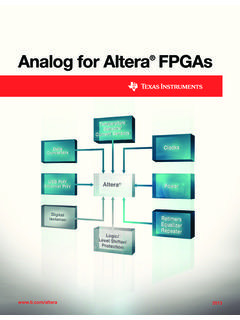Transcription of An Improved 2-Switch Forward Converter Application
1 An Improved 2-Switch Forward Converter ApplicationAgenda1. Generalities on Forward converters2. Core reset: tertiary winding, RCD clamp, 2-Switch forward3. Specs review of the NCP1252 s demo board4. Power components calculation 5. NCP1252 components calculation6. Closed-loop feedback: simulations and compensation7. Demo board schematics & Board performance review9. ConclusionsAgenda1. Generalities on Forward converters2. Core reset: tertiary winding, RCD clamp, 2-Switch forward3. Specs review of the NCP1252 s demo board4. Power components calculation 5. NCP1252 components calculation6. Closed-loop feedback: simulations and compensation7.
2 Demo board schematics & Board performance review9. ConclusionsGeneralities About the 1-Switch Forward ConverterPROs It is a transformer- isolated buck -derived topology It requires a single transistor, ground referenced Non-pulsating output current reduces rms content in the capsCONs Smaller power capability than a full or half-bridge topology Limited in duty-cycle (duty ratio) excursion because of core reset The drain voltage swings to twice the input voltage or moreAgenda1. Generalities on Forward converters2. Core reset: tertiary winding, RCD clamp, 2-Switch forward3. Specs review of the NCP1252 s demo board4.
3 Power components calculation 5. NCP1252 components calculation6. Closed-loop feedback: simulations and compensation7. Demo board schematics & Board performance review9. ConclusionsD1D2 CRQ1 Vin0 LmagLX1 Transformer Core Reset: Why?Q1 ILmag Without transformer core reset:tt The current builds up at each switching cycle It brings the core into saturationCRD2D1Q1 VinLmagL0X1D3 Transformer Core Reset: Why? With transformer core reset:tt The current does not build up at each switching cycle Volt-seconds average to zero during each cycle The voltage reverses over Lmagand resets itQ1 ILmagCore Reset Techniques: How ?
4 Energy is stored in the magnetizing inductor This energy does not participate to the power transfer It needs to be released to avoid flux walk away 3 common standard techniques for the core reset:9 Tertiary winding9 RCD clamp92-switch forwardCore Reset Techniques: Tertiary WindingCRD2D1Q1 VinLmagL0X1D3 Reset with the 3rdwinding Duty ratio can be > 50%But/Q1peak voltage can be > 2 Vin/3rdwinding for the transformer 3rdwindingCore Reset Techniques: RCD ClampCRD2D1Q1 VinLmagL0X2 XFMR1 RclampCclampDclamp Reset with RCD clamp Duty ratio can be > 50%But/Writing equation and simulation are required for checking the correct reset /Lower cost than 3rdwinding techniqueRCD clampCRD2D1 VinQ1 LmagX1L0Q2D4D3 Core Reset Techniques: 2-Switch Forward Reset with a 2-Switch Forward Easy to implement Q1peak voltage is equal to VinBut/Additional power MOSFET (Q2) + high side driver/2 High voltage, low power diodes (D3& D4) 2-Switch Forward resetNote : Q1& Q2have same drive command2-Switch Forward : How Does It Works?
5 CRD2D1 VinQ1 LmagX1L0Q2D4D3 OFFONOFFOFFStep 3 ONONOFFOFFStep 2 OFFOFFONONStep 1D3& D4D2D1Q1& Q2 ILmagILStep 1 Step 2 Step 3 Note : Primary controller status on time : Step1 off time : Step 2 + Step 3ttAgenda1. Generalities on Forward converters2. Core reset: tertiary winding, RCD clamp, 2-Switch forward3. Specs review of the NCP1252 s demo board4. Power components calculation 5. NCP1252 components calculation6. Closed-loop feedback: simulations and compensation7. Demo board schematics & Board performance review9. ConclusionsUnique FeaturesBenefitsValue PropositionMain differences with the UC384X series14 CCPG Jun-09 The NCP1252 offers everything needed to build a cost-effective and reliable ac-dc switching power supply.
6 Adjustable soft start duration Internal ramp compensation Auto-recovery brown-out detection Vcc up to 28 V with auto-recovery UVLO Frequency jittering 5% of the switching frequency Duty cycle 50% with A Version, 80% with B versionOthers FeaturesOrdering & Package InformationMarket & ApplicationsNCP1252 Fixed Frequency Controller Featuring Skip Cycle and Latch OCP ATX Power supply AC adapters NCP1252 ADR2G: 50% Duty Cycle SOIC8 NCP1252 BDR2G: 80% Duty Cycle SOIC8 Adjustable switching freq. Delayed operation upon startup Latched Short circuit protection timer based. skip cycle mode Design flexibility independent of the aux.
7 Winding Allow temporary over load and latch permanent fault Achieve real no load operationYesNo5 V voltage start No120 msDelay on startup NoLatch-off, 15 ms delayPre-short protection NoYesBrown-Out with shutdown featureNoYesSkip Cycle (light load behavior)No300 Hz, 5%Frequency jittering Ramp CompensationNoYesLeading Edge Blanking (LEB)500 A< 100 AStartup currentUC3843/5 NCP1252UC3843/5 Application ExempleBOPre-short protectionSSDelay upon startupUC3843/5 UC384X does not include brown-out, soft-start and overload detection the external implementation cost of these functions is $ NCP1252 includes them all, reducing cost and improving reliabilitySpec Review: NCP1252 s Demo Board Input voltage range: 340-410 V dc Output voltage: 12 V dc, 5% Nominal output power: 96 W(8 A) Maximal output power: 120 W(5 seconds per minute) Minimal output power: real no load(no dummy load!)
8 Output ripple : 50 mV peak to peak Maximum transient load step: 50% of the max load Maximum output drop voltage: 250 mV(from Iout = 50% to Full load (5 A 10 A) in 5 s)Agenda1. Generalities on Forward converters2. Core reset: tertiary winding, RCD clamp, 2-Switch forward3. Specs review of the NCP1252 s demo board4. Power components calculation 5. NCP1252 components calculation6. Closed-loop feedback: simulations and compensation7. Demo board schematics & Board performance review9. ConclusionsPower Components Calculation: Transformer (1/3) Step 1: Turns ratio calculation in CCM:120 9 350 0 450085outbulk minmaxoutbulk = = = =Where: Voutis the output voltage isthe targeted efficiency Vbulkminis the min.
9 Input voltage DCmaxis the max duty cycle of the NCP1252 N is the transformer turn ratioPower Components Calculation: Transformer (2/3) Step 2: Verification: Maximum duty cycle at high input line DCmin(Based on the previous equation)1209 410 008538 2outbulk maxminoutminbulk % = = = =Where: Voutis the output voltage isthe targeted efficiency Vbulkmaxis the max. input voltage N is the transformer turn ratioPower Components Calculation: Transformer (3/3) Step 3: Magnetizing inductor value. For resetting properly the core, a minimal magnetizing current is needed to reverse the voltage across the winding.
10 (Enough energy must be stored so to charge the capacitance) Rule of thumb: Magnetizing current = 10% primary peak current( ILmag_pk= 10% Ip_pk)ILmagIptt35013 4 mH1001 094045125bulk _ minmagp_ DCminTswPower Components Calculation: LC Output Filter (1/4) Step 1: Crossover frequency (fc) selection arbitrarily selected to 10 kHz. fc> 10 kHz requires noiseless layout due to switching noise (difficult). Crossover at higher frequency is not recommended Step 2: Cout& RESR estimation If we consider a Vout= 250 mV dictated by fc, Cout& Iout, we can write the following equation:ESR5318 318 outoutoutcoutESRcoutICCfVRmfC Where: fccrossover frequency Ioutis the max.
